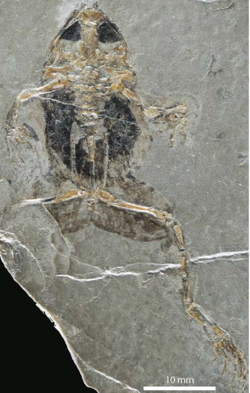Biology:Eodiscoglossus
| Eodiscoglossus | |
|---|---|

| |
| Holotype specimen of E. santonjae | |
| Scientific classification | |
| Domain: | Eukaryota |
| Kingdom: | Animalia |
| Phylum: | Chordata |
| Class: | Amphibia |
| Order: | Anura |
| Genus: | †Eodiscoglossus Villalta, 1957 |
| Type species | |
| Eodiscoglossus santonjae Villalta, 1957
| |
| Other species | |
| |
Eodiscoglossus is an extinct genus of prehistoric frogs. It is known from the type species E. santonjae from the Early Cretaceous (Barremian) El Castellar Formation of Spain , as well as a referred species E. oxoniensis known from the Forest Marble Formation of the UK.[1][2][3] It was a small primitive frog, with a length of only 27 mm (1.1 in) from the premaxilla to the ischium.[2] Formerly considered to be closely related to discoglossids, E. santonjae is now regarded as close to the root of the crown group of modern frogs[3] in a position more derived than New Zealand frogs and tailed frogs, but more basal than costatans like alytids and other more advanced frogs like neobatrachians. The morphology of E. santonjae suggests a generalist and unspecialised movement habit.[4] The referral of E. oxoniensis to Eodiscoglossus has been questioned, as it is much earlier than the type species and it is based on homoplasic and plesiomorphic characteristics inherited from a common ancestor, so there is no clear evidence of a close relation.[5]
See also
- Prehistoric amphibian
- List of prehistoric amphibians
References
- ↑ "†Eodiscoglossus Villalta 1957". Paleobiology Database. Fossilworks. http://www.fossilworks.org/cgi-bin/bridge.pl?a=taxonInfo&taxon_no=37428.
- ↑ 2.0 2.1 Hecht, Max K. (1970). "The morphology of Eodiscoglossus, a complete Jurassic frog". American Museum Novitates (2424): 1–17.
- ↑ 3.0 3.1 Báez, Ana Maria; Gómez, Raúl O. (2016). "Revision of the skeletal morphology of Eodiscoglossus santonjae, an Early Cretaceous frog from northeastern Spain, with comments on its phylogenetic placement". Fossil Imprint 72 (1–2): 67–77. doi:10.14446/fi.2016.67. ISSN 2533-4069.
- ↑ Gómez, Raúl O.; Lires, Andres I. (October 2019). "High ecomorphological diversity among Early Cretaceous frogs from a large subtropical wetland of Iberia" (in en). Comptes Rendus Palevol 18 (7): 711–723. doi:10.1016/j.crpv.2019.07.005. https://linkinghub.elsevier.com/retrieve/pii/S1631068319301320.
- ↑ Báez, Ana M.; Gómez, Raúl O. (2019). "Redescription of the overlooked basal frog Wealdenbatrachus reveals increased diversity among Early Cretaceous anurans" (in en). Cretaceous Research 99: 14–29. doi:10.1016/j.cretres.2019.02.006.
Wikidata ☰ Q5381657 entry
 |

